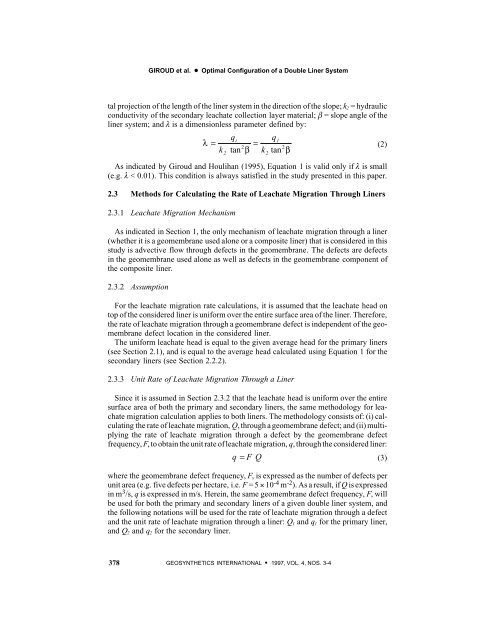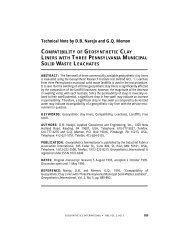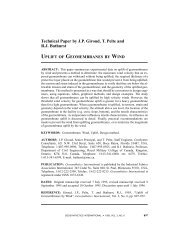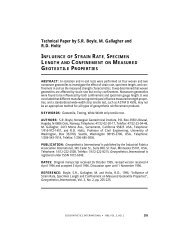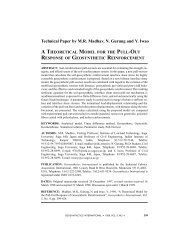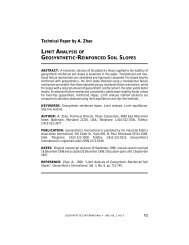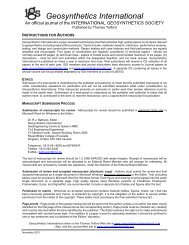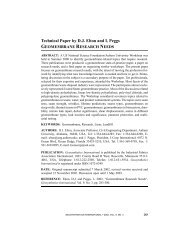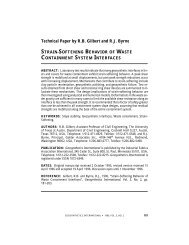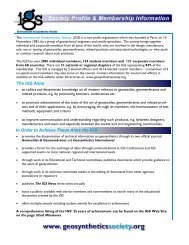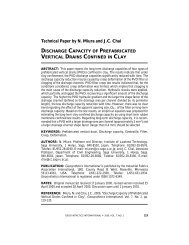Technical Paper by JP Giroud, KL Soderman and K. Badu-Tweneboah
Technical Paper by JP Giroud, KL Soderman and K. Badu-Tweneboah
Technical Paper by JP Giroud, KL Soderman and K. Badu-Tweneboah
You also want an ePaper? Increase the reach of your titles
YUMPU automatically turns print PDFs into web optimized ePapers that Google loves.
GIROUD et al. D Optimal Configuration of a Double Liner System<br />
tal projection of the length of the liner system in the direction of the slope; k 2 = hydraulic<br />
conductivity of the secondary leachate collection layer material; β = slope angle of the<br />
liner system; <strong>and</strong> λ is a dimensionless parameter defined <strong>by</strong>:<br />
qi<br />
q1<br />
l = =<br />
2 2<br />
(2)<br />
k tan b k tan b<br />
2<br />
As indicated <strong>by</strong> <strong>Giroud</strong> <strong>and</strong> Houlihan (1995), Equation 1 is valid only if λ is small<br />
(e.g. λ < 0.01). This condition is always satisfied in the study presented in this paper.<br />
2.3 Methods for Calculating the Rate of Leachate Migration Through Liners<br />
2.3.1 Leachate Migration Mechanism<br />
As indicated in Section 1, the only mechanism of leachate migration through a liner<br />
(whether it is a geomembrane used alone or a composite liner) that is considered in this<br />
study is advective flow through defects in the geomembrane. The defects are defects<br />
in the geomembrane used alone as well as defects in the geomembrane component of<br />
the composite liner.<br />
2.3.2 Assumption<br />
For the leachate migration rate calculations, it is assumed that the leachate head on<br />
top of the considered liner is uniform over the entire surface area of the liner. Therefore,<br />
the rate of leachate migration through a geomembrane defect is independent of the geomembrane<br />
defect location in the considered liner.<br />
The uniform leachate head is equal to the given average head for the primary liners<br />
(see Section 2.1), <strong>and</strong> is equal to the average head calculated using Equation 1 for the<br />
secondary liners (see Section 2.2.2).<br />
2.3.3 Unit Rate of Leachate Migration Through a Liner<br />
Since it is assumed in Section 2.3.2 that the leachate head is uniform over the entire<br />
surface area of both the primary <strong>and</strong> secondary liners, the same methodology for leachate<br />
migration calculation applies to both liners. The methodology consists of: (i) calculating<br />
the rate of leachate migration, Q, through a geomembrane defect; <strong>and</strong> (ii) multiplying<br />
the rate of leachate migration through a defect <strong>by</strong> the geomembrane defect<br />
frequency, F, to obtain the unit rate ofleachate migration, q, through the considered liner:<br />
q = F Q<br />
(3)<br />
where the geomembrane defect frequency, F, is expressed as the number of defects per<br />
unit area (e.g. five defects per hectare, i.e. F =5× 10 -4 m -2 ). As a result, if Q is expressed<br />
in m 3 /s, q is expressed in m/s. Herein, the same geomembrane defect frequency, F, will<br />
be used for both the primary <strong>and</strong> secondary liners of a given double liner system, <strong>and</strong><br />
the following notations will be used for the rate of leachate migration through a defect<br />
<strong>and</strong> the unit rate of leachate migration through a liner: Q 1 <strong>and</strong> q 1 for the primary liner,<br />
<strong>and</strong> Q 2 <strong>and</strong> q 2 for the secondary liner.<br />
2<br />
378 GEOSYNTHETICS INTERNATIONAL S 1997, VOL. 4, NOS. 3-4


